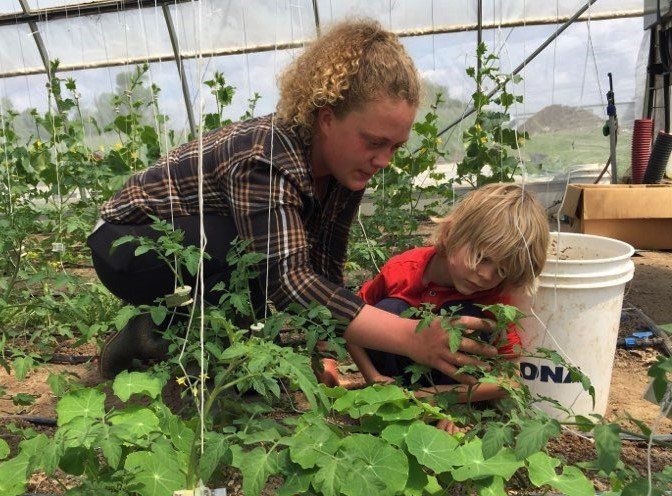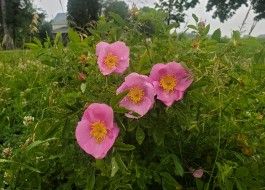June 24, 2021
The Lettuce Rejoice!
Firmly Rooted Farm's Newsletter for their Veggie Loving Farm-ily

On the Farm: The Farm as an Ecosystem
Hello again my veggie loving friends,
If you are a dedicated reader of this newsletter or a follower of us on social media, you may have noticed a bit of a theme. There are more than just vegetables in them thar fields. Snapping turtles, barn swallows, and killdeer find a nesting ground, a haven to usher new life into the world. Butterflies, bees, and birds find pollen and insects to flourish and feast. We exert our control over plantings, irrigations, and harvestings, but we understand our control is only an illusion. We have influence at the very most, over the grand ecosystem that is a farm, a role we understand still holds much power and should be considered carefully. Much occurs outside of our vision, outside of our thoughts, it is hard to even fathom the complexity such a small patch of land holds. Life bursts forth, with tenacity and resilience, whether we wish it to or not.
But how we wish it to. If you’ve ever visited the farm, you may have noticed the vibrant gardens, or the strips of land running along the edges of fields and the road, conserved for shrubbery and trees. These strips of land are hedgerows. Planted with native flowering and fruiting plants, this reserved land has been purposefully chosen as pockets for insects, birds, and other beneficial species and wildlife to flourish. We’ve provided the opportunity, and life takes it and runs wild.
Soil health is one aspect of the land that benefits from these hedgerows. The permanent cover provides pockets of soil that are never disturbed by farming practices, which allows there to be permanent sequestration of carbon on the farm. It also provides a permanent habitat for species we are trying to promote, such as microorganisms that are an integral part of soil health, as well as corridors for travel and havens for other species that find the farm a pit stop or a home for a time or two.
These hedgerows also provide habitat to pollinators. Often when one thinks of providing food for pollinators, they think of vibrant flowers, but many tree and shrub species offer important food sources. Early bloomers like Maple and Willow may not have striking features, but they provide important early food sources for bees. There are also many bird species that are excellent pollinators, while others are brilliant insect control. Many shrub species in the hedgerows yield fruit for only the birds, helping to secure diverse food sources for countless species.
We’ve recently received funding to continue building our permanent hedgerows, as well as funding for a snake hibernaculum and bat houses. These projects will help increase the farm’s biodiversity and as a result, overall resiliency and ability to respond to ecological stressors. Additionally, we will be putting in a pond this year, further diversifying the habitat available to native species. This isn’t being done only because it helps us; we love providing a home for more than vegetables and fruits. Nature lovers at heart, we view ourselves as part of systems greater than our own ego. We wish to be even a tiny positive influence on the natural systems around us. For Tamara, Brian, and every employee that works with them, farming is more than an economic endeavour, but a chance to be passionate about positive change. It's a chance to relish in the bounty of nature, a chance to work alongside the natural systems around us, and a chance to attempt harmony with the natural world. Farming fosters life within and without all of us.
We will be hosting a planting day in the fall for any volunteers who would like to part of the hedgerow project. Stay tuned, we’ll keep you posted when the time comes!
Kitchen Corner
Mid-June is scape season, a time of year where many vegetable farmers find themselves suddenly swimming in so many garlic scapes they feel they can hardly e-scape them (I know, groan). Scapes are the flowering head of garlic and must be harvested to promote healthy and strong formation of garlic bulbs, otherwise, the plant will divert energy into flower formation rather than bulb formation. Luckily scapes are delicious; because their season is short and abundant, one often ends up eating many in a short time frame. I enjoy scapes sauteed with some butter or tossed with oil and salt and grilled on a hot BBQ, allowing for charred tips. To prolong my scape enjoyment, I make scape pesto, which I enjoy with greater fervour than regular pesto. Just follow a regular pesto recipe, such as the one I shared for carrot top pesto, and add a little basil to round out the garlicy flavours. Additionally, one could ferment scapes in brine or pickle them in a liquid. You can read all about lacto-fermenting vegetables here and find a great scape pickling recipe here.
Kitchen Clean-Up
There are a lot of new members as part of our summer Farm Share, who may have lots of unanswered questions. Harvie University can answer nearly any question you have about customization, changing pick-up locations, etc. And if you find yourself with questions Harvie cannot answer, feel free to reach out by email farmshare@firmlyrooted.ca.
That’s all for now folks, happy eating until next time!
Farmer Erika



